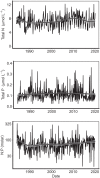Sustained stoichiometric imbalance and its ecological consequences in a large oligotrophic lake
- PMID: 35858403
- PMCID: PMC9335326
- DOI: 10.1073/pnas.2202268119
Sustained stoichiometric imbalance and its ecological consequences in a large oligotrophic lake
Abstract
Considerable attention is given to absolute nutrient levels in lakes, rivers, and oceans, but less is paid to their relative concentrations, their nitrogen:phosphorus (N:P) stoichiometry, and the consequences of imbalanced stoichiometry. Here, we report 38 y of nutrient dynamics in Flathead Lake, a large oligotrophic lake in Montana, and its inflows. While nutrient levels were low, the lake had sustained high total N: total P ratios (TN:TP: 60 to 90:1 molar) throughout the observation period. N and P loading to the lake as well as loading N:P ratios varied considerably among years but showed no systematic long-term trend. Surprisingly, TN:TP ratios in river inflows were consistently lower than in the lake, suggesting that forms of P in riverine loading are removed preferentially to N. In-lake processes, such as differential sedimentation of P relative to N or accumulation of fixed N in excess of denitrification, likely also operate to maintain the lake's high TN:TP ratios. Regardless of causes, the lake's stoichiometric imbalance is manifested in P limitation of phytoplankton growth during early and midsummer, resulting in high C:P and N:P ratios in suspended particulate matter that propagate P limitation to zooplankton. Finally, the lake's imbalanced N:P stoichiometry appears to raise the potential for aerobic methane production via metabolism of phosphonate compounds by P-limited microbes. These data highlight the importance of not only absolute N and P levels in aquatic ecosystems, but also their stoichiometric balance, and they call attention to potential management implications of high N:P ratios.
Keywords: ecosystem; limnology; nitrogen; phosphorus; stoichiometry.
Conflict of interest statement
The authors declare no competing interest.
Figures






References
-
- Falkowski P., et al. , The global carbon cycle: A test of our knowledge of earth as a system. Science 290, 291–296 (2000). - PubMed
-
- Schindler D. W., Evolution of phosphorus limitation in lakes. Science 195, 260–262 (1977). - PubMed
-
- Diaz R. J., Rosenberg R., Spreading dead zones and consequences for marine ecosystems. Science 321, 926–929 (2008). - PubMed
Publication types
MeSH terms
Substances
LinkOut - more resources
Full Text Sources
Miscellaneous

